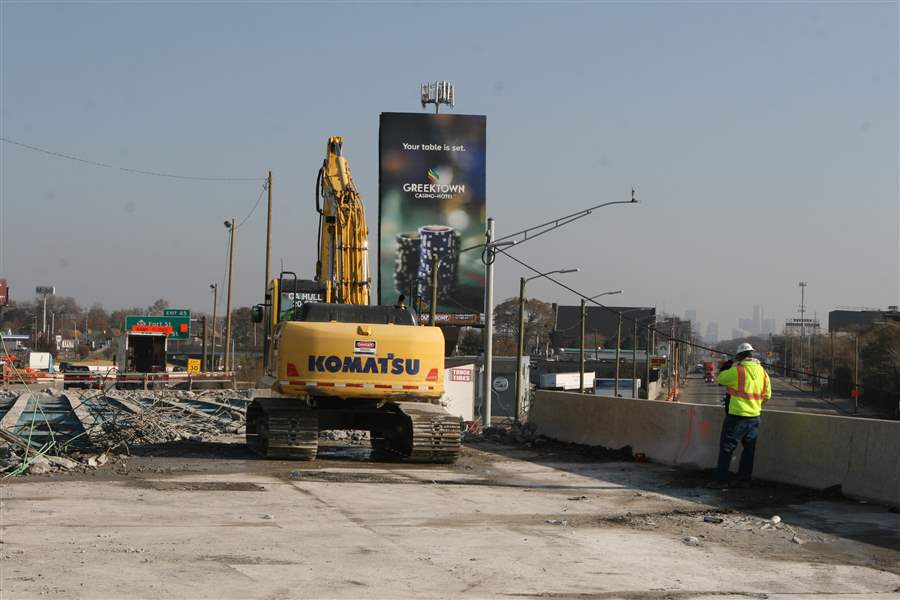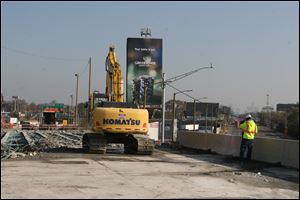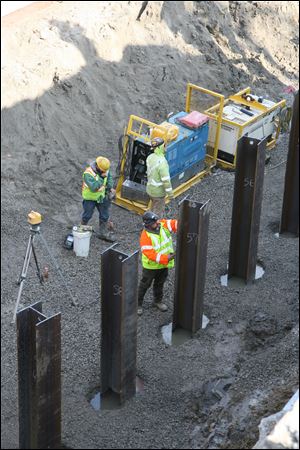
Major I-75 project in Michigan passes midway point
11/19/2017
Although it officially has a year to go, the Michigan Department of Transportation's massive bridge project that has closed southbound I-75 south of Detroit since February passed its midway point earlier this month.
THE BLADE/DAVID PATCH
Buy This Image
The Michigan Department of Transportation’s massive bridge project that has closed southbound I-75 south of Detroit since February has passed its midway point, and a project official is cautiously optimistic it could be finished ahead of schedule.
But that’s going to depend on redecking the huge River Rouge bridge’s northbound lanes, replacing the northbound half of the Goddard Road viaduct, and rehabilitation of 13 smaller bridges between Goddard and Sibley roads going as smoothly as has the work completed so far.

Although it officially has a year to go, the Michigan Department of Transportation's massive bridge project that has closed southbound I-75 south of Detroit since February passed its midway point earlier this month.
“The schedule gives [the contractor] until about this time next year,” Bill Erben, the Michigan Department of Transportation’s project engineer, said last week. “Optimistically, I look to getting done earlier, but they have until the scheduled date to get done.”
For now, at least, northwest Ohio residents who regularly travel to Detroit or beyond for work, sporting events, concerts, and hunting season will need to navigate long detours when they return home. Southbound travel out of Detroit offers a choice between a 52-mile detour using I-96 and I-275 via Livonia, Mich., or shorter but slower — sometimes much slower — alternatives using Fort Street, Jefferson Avenue, or I-94 and Telegraph Road.
Traffic across the Rouge bridge was switched from the regular northbound lanes to the newly rebuilt southbound side Nov. 9. Traffic in the Goddard area had been switched over to rebuilt bridges several weeks before.
Between those two locations, it crosses back over to the northbound side to maintain access to ramps at several interchanges. All southbound ramps remain closed in the area.
The traffic switch occurred at an ideal time, Mr. Erben said, because the major task of demolishing the Rouge bridge’s northbound deck is not particularly weather sensitive.
“There’s so much demolition, we should be in the warmer weather by the time we’re ready to cast the [replacement] deck,” he said.
The smaller bridges’ rehabilitation, however, will add a new wrinkle to the construction zone.

Crews work on a major I-75 construction project south of Detroit.
During this year’s construction, which mainly involved work on I-75’s southbound side at the Rouge and Goddard bridges, three lanes of northbound traffic were maintained throughout.
But when work starts on the smaller bridges south of Goddard, northbound I-75 will be reduced to two lanes between the U.S. 24 Connector in Taylor, Mich., and Northline Road in neighboring Southgate. That will likely throw a wrench into the morning commute, which so far has been relatively unimpeded by the I-75 construction.
That work’s start will also lengthen the section of southbound I-75 that’s closed.
Motorists now may enter southbound I-75 starting at the Northline/Allen Road interchange, but sometime in early 2018 the southbound bridges from there down to the U.S. 24 Connector will be closed for rehabilitation. That will shut down southbound access from Northline/Allen and from Eureka Road for most of the year.
Four lanes wide in both directions, the Rouge bridge features the largest concrete bridge decks in Michigan. Removing the old decks involves cutting them out in sections and carrying them off the structure to be pulverized.
The replacement decks, meanwhile, require enough concrete to cover 24 football fields, Mr. Erben said.
During the southbound lanes’ deck replacements, the project engineer said, workers found steel bridge beams needing more repair than expected, but that was accomplished without significantly delaying construction.
The Goddard viaduct is being replaced with two smaller bridges in both directions — one spanning Goddard itself, the other spanning Sexton and Kilfoil Drain, a small creek. The former viaduct rose to a higher elevation to cross railroad tracks that no longer exist.
The smaller replacement bridges will be cheaper to maintain, Mr. Erben said, and one of the southbound structures uses experimental carbon-fiber strands instead of traditional steel bars to reinforce its concrete.
New embankment between the bridges, meanwhile, includes expanded-polystyrene blocks in place of much of its earthen fill.
“The pavement section just floats over it,” Mr. Erben said. “There’s a lot less settling than with traditional fill.”
Contact David Patch at dpatch@theblade.com or 419-724-6094.